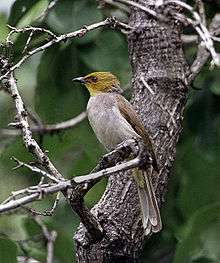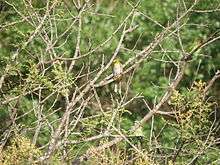Yellow-throated bulbul
| Yellow-throated bulbul | |
|---|---|
 | |
| Scientific classification | |
| Kingdom: | Animalia |
| Phylum: | Chordate |
| Class: | Aves |
| Order: | Passeriformes |
| Family: | Pycnonotidae |
| Genus: | Pycnonotus |
| Species: | P. xantholaemus |
| Binomial name | |
| Pycnonotus xantholaemus (Jerdon, 1845) | |
 | |
| Synonyms | |
The yellow-throated bulbul (Pycnonotus xantholaemus) is a species of bulbul endemic to southern peninsular India. They are found on scrub habitats on steep, rocky hills many of which are threatened by granite quarrying. It is confusable only with the white-browed bulbul with which its range overlaps but is distinctively yellow on the head and throat apart from the yellow vent. The calls of this species are very similar to that of the white-browed bulbul.
Description
This uncrested species of bulbul is olive grey above with a yellow throat, undertail coverts and tail tips. The head is plain while the breast and belly have a grey wash. The closest resembling species is the white-browed bulbul but this has a supercilium and lacks the yellow throat. Males and females are similar in plumage.[4]
The name of Konda-poda-pigli in Telugu was noted by TC Jerdon.[5]
Distribution and habitat

The habitat of the species is rocky, scrub covered hills mostly in the Eastern Ghats and central peninsular India but also in some places in the Western Ghats. The distribution is highly fragmented and populations are very local making hilly habitats of very special conservation concern. Many of these hill forests are threatened by granite quarrying, forest fires and grazing.[6] It has vanished from many sites where it was earlier known.[7]
Some well known locations include the Nandi Hills,[8] Horsley Hills,[9] Gingee,[10] Yercaud[11] and the Biligirirangans.[12] The species is also seen in some parts of the Western Ghats including the Anamalais.[13][14][15][16] The northern limit is believed to be in the Nallamala range[17] but it is suspected that the species may extend in range into the northern Eastern Ghats of Orissa.[18][19]
Behaviour and ecology
This bird is usually shy and hidden within scrub and is usually detected by its sudden cackling outbursts of calls which are similar to those of the white-browed bulbul. They feed on insects and the berries of various scrub plant species including Lantana camara, Securinega leucopyrus, Toddalia asiatica, Erythroxylon monogynum, Solanum indicum, Santalum album, Ziziphus, Ficus benghalensis, Ficus nervosa, Ficus montana, Canthium dicoccum and Phyllanthus reticulata.[6]

During hot afternoons and in the dry-season they visit pools of water both to drink and bathe.[20]
The breeding season is June to August. The nest is built in the fork of small tree. Two eggs are laid which hatch in 20 days with the chicks fledging 13 days later.[6][21]
References
- ↑ BirdLife International (2013). "Pycnonotus xantholaemus". IUCN Red List of Threatened Species. Version 2013.2. International Union for Conservation of Nature. Retrieved 26 November 2013.
- ↑ Jerdon, TC (1844). "Second supplement to the catalogue of the birds of southern India". Madras Journal of Literature and Science. 13 (2): 116–144.
- ↑ Sharpe, RB (1881). Catalogue of the birds in the British Museum. Volume 6 Cichlomorphae: Part 3. p. 146.
- ↑ Ali, S & S D Ripley (1996). Handbook of the birds of India and Pakistan. 6 (2nd ed.). Oxford University Press. pp. 94–95. ISBN 0-19-562063-1.
- ↑ Jerdon, TC (1863). The Birds of India. Vol 2 Part 1. p. 85.
- 1 2 3 Subramanya, S.; JN Prasad & S. Karthikeyan (2006). "Status, habitat, habits and conservation of Yellow-throated Bulbul Pycnonotus xantholaemus (Jerdon) in South India". Journal of the Bombay Natural History Society. 103 (2-3): 215–226.
- ↑ Subramanya,S; Karthikeyan,S; Prasad,JN; Srinivasa,TS; Arun,B (1990). "A trip to Thondebhavi in search of Yellowthroated Bulbul". Newsletter for Birdwatchers. 30 (11-12): 7.
- ↑ Subramanya,S; Karthikeyan,S; Prasad,JN (1991). "Yellowthroated Bulbul at Nandi Hill". Newsletter for Birdwatchers. 31 (3&4): 7–8.
- ↑ Allen,P Roscoe (1908). "Notes on the Yellow-throated Bulbul Pycnonotus xantholaemus". J. Bombay Nat. Hist. Soc. 18 (4): 905–907.
- ↑ Rao,TK (1995). "Yellowthroated Bulbul - Pycnonotus xantholaemus (Jerdon) in Gingee". Blackbuck. 11 (1): 9–11.
- ↑ Karthikeyan,S (1995). "Notes on the occurrence of the Yellowthroated Bulbul Pycnonotus xantholaemus (Jerdon) at Shevaroys, Tamil Nadu". J. Bombay Nat. Hist. Soc. 92 (2): 266–267.
- ↑ Karthikeyan,S; Prasad,JN; Srinivasa,TS (1995). "Yellowthroated Bulbul Pycnonotus xantholaemus (Jerdon) at Biligirirangan Hills, Karnataka". J. Bombay Nat. Hist. Soc. 92 (1): 123–124.
- ↑ Narayanan, S. P.; Boopal, A.; Nanjan, S.; Kurian, J.; Dhanya, R.; Gomahty, N.; Dastidar, D. G.; Rajamamannan, M. A.; Venkitachalam, R.; Mukherjee, D. & Eswaran, R. (2006). "New site for the Yellow-throated Bulbul Pycnonotus xantholaemus from Tamil Nadu" (PDF). Indian Birds. 2 (6): 151–153.
- ↑ Beisenherz, W. (2004). "Rediscovery of the Yellow-throated Bulbul Pycnonotus xantholaemus in the Anaimalai Hills, Western Ghats, South India". J. Bombay Nat. Hist. Soc. 101 (1): 160.
- ↑ Praveen J & L Namassivayan (2006). "Sighting of Yellow-throated Bulbul Pycnonotus xantholaemus from Chinnar Wildlife Sanctuary, Kerala, Southern India" (PDF). Zoos' Print Journal. 21 (4): 2228. doi:10.11609/jott.zpj.1489.2228.
- ↑ Davison, W (1888). "Letters". Ibis. 30 (1): 146–148. doi:10.1111/j.1474-919X.1888.tb07729.x.
- ↑ Srinivasulu, C. (2003). "Site records of yellow-throated bulbul Pycnonotus xantholaemus (Jerdon, 1844) in the Nallamala Hills, Eastern Ghats, Andhra Pradesh, India" (PDF). Zoos' Print Journal. 18 (3): 1051–1052. doi:10.11609/jott.zpj.18.3.1051-2.
- ↑ Subramanya S. (2004). "Does the Yellow-throated Bulbul Pycnonotus xantholaemus occur in Orissa?". Newsletter for Ornithologists. 1 (3): 39–40.
- ↑ Sreekar R & Srinivasulu C (2010). "New site record of Yellow-throated Bulbul Pycnonotus xantholaemus from Andhra Pradesh" (PDF). Indian Birds. 5 (5): 157.
- ↑ Karthikeyan S (1991). "On birds frequenting water puddles". Newsletter for Birdwatchers. 31 (11&12): 8–9.
- ↑ Collar NJ; A.V. Andreev; S. Chan; M.J. Crosby; S. Subramanya; J.A. Tobias (2001). Threatened Birds of Asia (PDF). BirdLife International. pp. 1969–1973.
